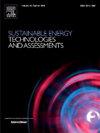A combined vehicle specific power and laboratory emissions approach to real driving CO2 emission estimation for light-duty vehicle
IF 7.1
2区 工程技术
Q1 ENERGY & FUELS
Sustainable Energy Technologies and Assessments
Pub Date : 2025-03-01
DOI:10.1016/j.seta.2025.104265
引用次数: 0
Abstract
The influence of CO2 on Earth’s climate warming is significant. To quantitatively evaluate RDE (Real Driving Emission) CO2 emissions based on laboratory test cycles, ten China 6 light-duty vehicles were tested under the WLTC (Worldwide Light-duty Driving Test Cycle), CLTC-P (China Light-duty Vehicle Test Cycle), and RDE tests. This study identified that the reference CO2 emission factors for conventional vehicles and PHEVs (Plug-in Hybrid Electric Vehicles) were 9.59–27.36 % and 32.30–45.01 % higher than the tested CO2 emissions, respectively. This suggested that setting CO2 emission limits based on the method in fuel consumption regulation could not effectively reduce CO2 emissions, particularly for PHEVs. The linear relationship between laboratory and RDE average CO2 emission in each VSP (Vehicle Specific Power) Bin suggested that the RDE average CO2 emission can be corrected to reduce the impact of driving behaviour and traffic conditions. The laboratory-based RDE emissions were obtained by replacing the frequency ratios of each VSP bin in the RDE tests with those from the laboratory cycles, and this method was helpful to establish RDE CO2 emission limits. For PHEVs, when the WLTC was used as a benchmark, RDE CO2 emissions from aggressive driving and traffic congestion were 9.48–14.87 g/km and 20.04–20.31 g/km, respectively. These emissions were 5.49 g/km and 20.52 g/km when the CLTC-P was used as the benchmark.
轻型车辆实际驾驶CO2排放估算的车辆比功率与实验室排放相结合方法
二氧化碳对地球气候变暖的影响是显著的。为了定量评价基于实验室测试循环的RDE (Real Driving Emission) CO2排放量,在WLTC (Worldwide light-duty Driving test Cycle)、CLTC-P (China light-duty Vehicle test Cycle)和RDE测试下对10辆中国6轻型汽车进行了测试。研究发现,传统汽车和插电式混合动力汽车(phev)的参考CO2排放系数分别比测试CO2排放系数高9.59 ~ 27.36%和32.30 ~ 45.01%。这表明,基于油耗监管方法设定CO2排放限值并不能有效减少CO2排放,特别是对于插电式混合动力汽车。每个VSP (Vehicle Specific Power) Bin的实验室平均CO2排放量与RDE平均CO2排放量之间的线性关系表明,RDE平均CO2排放量可以进行校正,以减少驾驶行为和交通状况的影响。通过将RDE试验中每个VSP箱的频率比替换为实验室循环的频率比,获得实验室RDE排放,该方法有助于建立RDE CO2排放限值。对于插电式混合动力车,当以WLTC为基准时,侵略性驾驶和交通拥堵的RDE CO2排放量分别为9.48-14.87 g/km和20.04-20.31 g/km。当以CLTC-P为基准时,这些排放量分别为5.49 g/km和20.52 g/km。
本文章由计算机程序翻译,如有差异,请以英文原文为准。
求助全文
约1分钟内获得全文
求助全文
来源期刊

Sustainable Energy Technologies and Assessments
Energy-Renewable Energy, Sustainability and the Environment
CiteScore
12.70
自引率
12.50%
发文量
1091
期刊介绍:
Encouraging a transition to a sustainable energy future is imperative for our world. Technologies that enable this shift in various sectors like transportation, heating, and power systems are of utmost importance. Sustainable Energy Technologies and Assessments welcomes papers focusing on a range of aspects and levels of technological advancements in energy generation and utilization. The aim is to reduce the negative environmental impact associated with energy production and consumption, spanning from laboratory experiments to real-world applications in the commercial sector.
 求助内容:
求助内容: 应助结果提醒方式:
应助结果提醒方式:


